Dusting
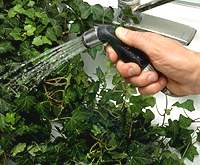
Care for your houseplants by rinsing dust off their leaves.
- Help plants breathe by cleaning their leaves. Many plants can be washed quickly by placing them in the sink or shower and gently spraying with lukewarm water. Wrap plastic bags around the bases to keep the soil in the pots. Let the plants drip dry.
- To clean the dust from large, smooth-leaved plants, hold one hand under a leaf and wipe gently with a rag in the other.
- To clean hairy-leaved plants, such as African violets and gloxinias, dust with a dry cotton swab, pipe cleaner, or soft cosmetic or watercolor brush.
- You can give plants a florist shine with purchased sprays or liquids, or with a cloth dipped in milk. Do not get any of these solutions on the leaf undersides. They may clog the stomata, the leaves' breathing organs.
continue reading below
Shape Ups
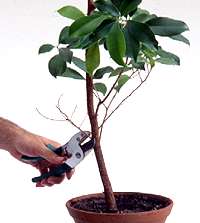
- To give shape to plants like philodendron and ivy, wind the long, trailing branches up over the pot in a pleasing pattern, then pin them to the soil at several points with hairpins, bent pipe cleaners, or bent paper clips. Do this every few months. The branches probably will root at these points, giving you a lusher-looking plant.
- Some plants need to be trimmed into shape. Always cut away any dead or broken branches. Pruning back the top and end growth encourages side growth.
- Remove dead leaves. Even the lushest foliage may hide dead leaves, so examine your plants periodically.
Food and Water
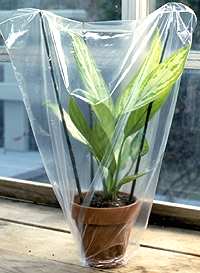
Plastic Tent
- When watering, use tepid water. If your water is high in chlorine, let it stand a day uncovered before watering plants.
- To test the soil for moisture, stick your finger at least 1/2 inch into the soil. Small pots may need water every day or two. Large ones may go a week between waterings. Check often; experience soon will tell you when to water.
- Add water until it drains through the hole in the bottom of the pot and shows in the saucer. This ensures that the entire root area receives a thorough soaking. Empty the saucer about 20 minutes after watering.
- If you're away from home, you can keep plants healthy for up to three weeks by watering them, then covering with makeshift plastic tents. Use bamboo or plastic stakes or bent clothes hangers to support the plastic above the plant leaves.
- Buy a good balanced houseplant fertilizer for most plants, a specialized one if you have African violets, bromeliads, or orchids. The three numbers on the fertilizer label (such as 10-20-10) refer to the levels of nitrogen, phosphorus, and potassium. Nitrogen gives the plant lush foliage. Phosphorus keeps roots and stems strong and healthy. Potassium encourages blooms.
- Plants need little feeding in the winter when they are almost dormant. Fertilize more in the spring and summer when they are growing more actively.
Take good care of your plants and they'll improve your home's air -- find out how by clicking here.
The Right Light
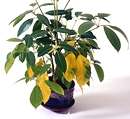
- Give your plants a quarter to half turn each week. This will give them nice rounded shapes.
- Watch for signs that your plants aren't getting enough light. Foliage plants often get tall and spindly. As the photograph of the schefflera shows, leaves turn yellow and grow small.
Learn more about how to give your houseplants the right amount of light.
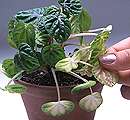
- This peperomia has been exposed to too much intense light, causing leaves to be sickly, lifeless, and colorless. Remove the lackluster leaves and move the plant away from direct sun.
Find out how to choose the right kind of plant grow lights!
Find the best houseplants for you with our Houseplant Finder!






 Care for your houseplants by rinsing dust off their leaves.
Care for your houseplants by rinsing dust off their leaves.

 Plastic Tent
Plastic Tent

